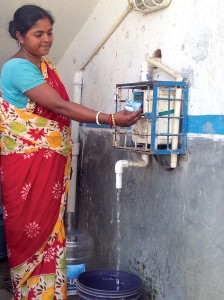And now… Water ATMs in Slums
What more could one ask for? We have a reliable source of drinking water, which is clean, safe and, most important, adequate, remarks Rinki Shaw of Kallikapur slum, located on the Eastern Metropolitan Bypass in Kolkata. She is among the many women in the area who have been using a smart card for around two years now to collect 10 litres of potable water every morning for the entire family from an automatic water dispensing machine.
The slum dwellers of Ward Numbers 108 and 109 in Kolkata have gone high-tech with a vengeance. All of them deftly use their smart cards to pick up their quota of free water from the various compact water dispensing machines, popularly known as water ATMs, installed in their neighbourhoods.
Despite living beside a huge pond, access to potable water was the biggest problem at Kallikapur. Most women would wake up at the crack of dawn and rush to the nearest hand pump to queue up for their turn to fill up drums and buckets with water for their homes. Earlier, there was no guarantee that they would return with water. Most of the times, either the hand pump would run dry or the municipal public taps, installed few and far between, would get no supply. And there was every chance of the stored water getting contaminated.
 But now, getting water is no longer the torturous chore it used to be. The women simply walk over to a water ATM at their convenience to take home their share without worrying whether there’d be any left.
But now, getting water is no longer the torturous chore it used to be. The women simply walk over to a water ATM at their convenience to take home their share without worrying whether there’d be any left.
The water is supplied to the community from a filtering plant that has been set up with the technical support of SAFE (South Asian Forum for Environment), a non-governmental science and environment organisation. It is a revolutionising measure. There was a time when the women here used to spend three to four hours daily collecting water. “We could not take care of our children or do household chores with a free mind because collecting water was always the first priority. At least with the water machines and smart cards, we don’t have to constantly worry about this chore. And, my children do not fall ill frequently, which is a big relief,” says Kavita Pal, who heads the joint liability group (JLG) that is in-charge of the monitoring and upkeep of the filtering plant.
The plant is supported by HSBC’s Water Programme that provided the initial funding and technical support for the sustainable model project. The water is taken from the nearby pond and filtered in the plant that has been built on community land. The water that cannot be purified is directed to community toilets, which are, in turn, connected to a biogas plant that produces fuel for use in the community kitchens. The filter plant runs on solar energy produced from the panels fitted on its roof, says Amrita Chatterjee, Director Communications and Research, SAFE.
Over the last two years, the project has gradually attained self-sustainability. The room that houses the filtering plant has huge solar grid that produces more than 10 KW of energy to run the facility. The water is supplied through underground channels from the nearby pond. Surface water from the pond is not used as people have inhibitions in drinking the dirty water that they use for cleaning and washing purposes. The plant purifies about 10,000 litres of water daily which is dispensed from three dispensers affixed in the slum.
The women simply walk over to a water ATM at their convenience to take home
their share, without worrying whether there’d be any left.
Though 10 litres come free, if someone needs more, they have the option of buying it, at fifty paise per litre, by topping up their smart cards with money. “The money helps in the upkeep and maintenance of the plant. The community members have learnt to operate and monitor the machines after receiving training from Eureka Forbes engineers who have installed the filters,” says Rabi Kumar Jana, who manages the filtering plant, the 24 community toilets, the biogas unit and the community kitchens.
A World Bank study revealed that poor quality drinking water causes 21 per cent of diseases in India, creating a burden of around Rs 300 crore for the government. This motivated SAFE to plan this project. India has been spending around Rs 1.48 crore every year since the 1990s on various Water Sanitation Hygiene projects but even then the country ranks 120 in a UNDP survey of 123 nations on ‘safe water index.’ According to the UNDP report, it is the urban slum dwellers that end up becoming worst victims of environmental pollution, poor sanitary services and contaminated drinking water.
The project is currently being replicated in two other urban slums in Kolkata now that the sustainability of the Kallikapur initiative has been measured and recognised. “For us women, it’s been a total win-win. More so because these days even the men have gotten involved in doing what was considered only a woman’s work. Earlier, they used to feel that collecting water, cleaning toilets and making food were activities done by women and girls. But with community ownership and participation, the onus of getting the work is being shared. Men and women have understood the merits of working side by side,” sums up a happy Rina Jana.
© Women’s Feature Service
